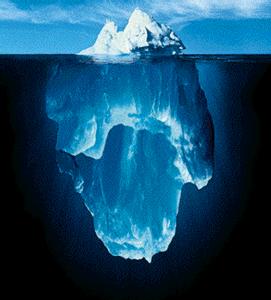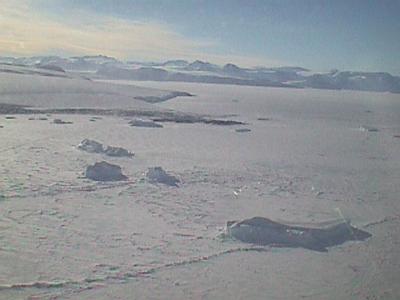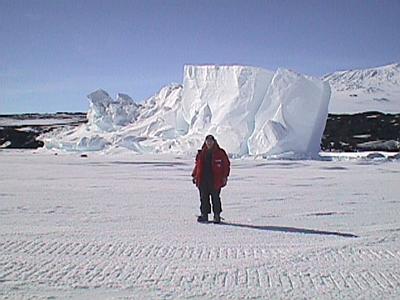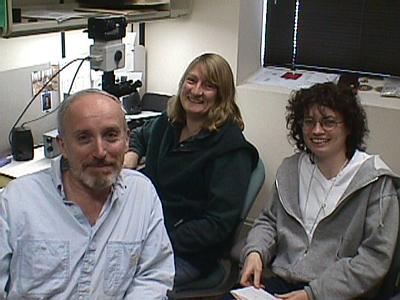18 November, 1999
Icebergs! I had the opportunity to see many icebergs up close since I have
been in Antarctica. In the area around Cape Roberts and in several other
locations, icebergs are frozen into the sea ice of the Ross Sea. These are
icebergs that got trapped in the winter before they reached the water of the
open sea. I walked around and up to several of these huge ice cubes. I even
had the opportunity to climb up on one.
Icebergs are fragments of ice sheets and glaciers that extend into a sea or
ocean. Icebergs will break off their ends and float in the surrounding
ocean. Ninety-three percent of the world's mass of icebergs is found
surrounding the Antarctic. Antarctic icebergs are characterized by their
tremendous size and tabular shape. Lengths up to five miles are not unusual,
with ice 150 feet above water. I saw several that were like medium sized
islands. Most Antarctic icebergs are formed from the Antarctic continental
ice sheet as it thins toward the coast and exudes into the ocean as a great
ice shelf with fronts hundreds of miles long. The glacial ice of most
icebergs has a specific gravity of .9 (Density = .9g/mL). This only means
that about 90% of the mass of an iceberg is below the sea. (See diagram.) An
icebergs' appearance depends upon how it is floating in the water. Many have
flat tops, looking like floating plateaus. This happens when the iceberg is
floating with the original surface of the glacier on top. These types of
icebergs are very dangerous to approach because slabs of glacial ice may
fall from the sides of the iceberg and throw ice and snow many hundreds of
feet. The icebergs may also roll over. As the waves and currents wear away
at the base of the glacier, the center of mass of the glacier will change
and the glacier will change position. After the iceberg does this, the
water-eroded surface is exposed. We walked up on one of these rolled over
bergs near Cape Roberts.
The icebergs I saw were all frozen in the sea ice, but when the ice melts
and these bergs reach open water, their movement will be influenced by wind
and ocean currents. The speed and direction of this movement is also
controlled by the size and shape of the iceberg, previous and present wind,
surface wind current, and general ocean current. Dirt and debris covered the
surface of many of the icebergs I saw. Icebergs transport pebbles, cobbles,
boulders, and finer material, and even plant and animal life, thousands of
miles from their source areas.
For more information about icebergs in the world, check out the Discovery
web site at: http://www.discovery.com/exp/icebergs/ice101.html.
Today's featured CRP Team Members are three members of the palynology team.
They are Rosemary Askin from Byrd Polar Research Center at Ohio State
University and John Wrenn from the Center for Excellence in Palynology at
Louisiana State University. Rosie and John work as palynologists in the
project. Palynologists study organic walled microfossils. John specializes
in dinoflagellates and acritarchs while Rosie focuses on fossil spores and
pollen. The other member of the team is Vanessa Thorn, a paleobotanist from
Victoria University in Wellington, New Zealand. Vanessa works to produce
photographic images of the fossils the palynologists find under the
microscope.
Note: I found an appropriate pan for the evaporation experiment. I
will start again tomorrow

Here is what an iceberg might look like under the water. As much as 90% of it's mass may be underwater. This image came from the following NASA website: http://dcb.larc.nasa.gov/larcst/Iceberg.html.

Here are a number of large bergs imbedded in the sea off Cape Roberts.

This is the nose of the Barnes Glacier on Ross Island. It is from the front of glaciers like this that icebergs calve off.

Here I am in front of a relatively small iceberg frozen in the sea.

From left to right: John Wrenn, Rosemary Askin and Vanessa Thorne. These are only some of the members of the POD.
Contact the TEA in the field at
.
If you cannot connect through your browser, copy the
TEA's e-mail address in the "To:" line of
your favorite e-mail package.
|
